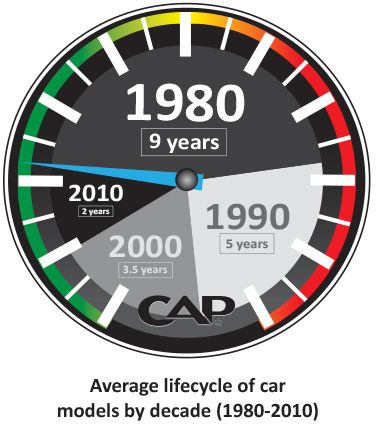
MOTORISTS benefit from the freshest choice of new cars in history – but the ever-shorter shelf life of models is hitting them in the wallet, according to car information experts CAP Automotive.
Analysis of new car model introductions over the past 3 decades by CAP reveals a dramatically shorter ‘shelf-life’ for today’s new vehicles than ever before.
While motorists benefit from ever more rapid advances in car quality, they pay a heavy price in increased depreciation as models go out of style quicker than they did 30 years ago.
Known in the industry as ‘lifecycle’, the period between replacement model introductions or significant ‘facelifts’ has shrunk from around 10 years in the 1970s and 80s to around 3-4 years today, CAP’s analysis reveals.
CAP new car expert David Saville said: “As Ford roll out their latest generation Fiesta – and Volkswagen bring out their latest Golf –you can’t help feeling like it’s only 2 minutes since the previous generation was introduced in each case.
“The outgoing Fiesta was produced between October 2008 and October 2012 and the previous Golf ran from November 2009 until November 2012.
“Looking back into history the first generation Fiesta was introduced in 1976 and ran until 1983. The Golf was introduced in 1974 and remained substantially unchanged until 1983. Therefore, over 3 decades these popular models have gone from a lifecycle approaching 10 years, with minimal technical changes, to around 4 years with quite often substantial technical changes under the skin each time.”
Saville attributes much of the impetus behind shortening lifecycles to the influence of far eastern manufacturers, who adopted a policy of refreshing their offerings more rapidly than the competition, as they worked hard to rapidly crack European markets.
He said: “To gain traction in more sophisticated and competitive markets than their own, far eastern manufacturers changed their models more rapidly than European carmakers.”
Another major influence on shortening lifecycles are ever tougher emissions standards, with manufacturers constantly working to meet rapidly changing European rules. Motorists themselves also contribute to the need for change as they increasingly choose cars that will cost them less in CO2-related taxes.
“Another significant aspect of shorter model lifecycles is the ease with which the look of a car can be changed, using modern automotive design techniques compared with 30 or 40 years ago.
“Now that computers are at the forefront of vehicle design and large areas of the front and rear of the car are manufactured from easily moulded plastics, it is simply easier to make significant cosmetic changes than it used to be. With every manufacturer wanting to get ahead of its rivals, there is now never a time when the next version of a model isn’t on the drawing board.”
Saville argues that while motorists benefit from constantly refreshing choices, they also pay for the ever shorter shelf-life of today’s cars.
He said: “On the face of it the new car consumer really benefits by always having a choice of bang up-to-date models to choose from. But this can also have a negative effect because most buyers have a car that they need to dispose of when they come back into the market. If their existing model isn’t the latest offering from that manufacturer, what the industry calls ‘lifecycle depreciation’ kicks in and makes their car less attractive as a private sale or a trade-in.”





